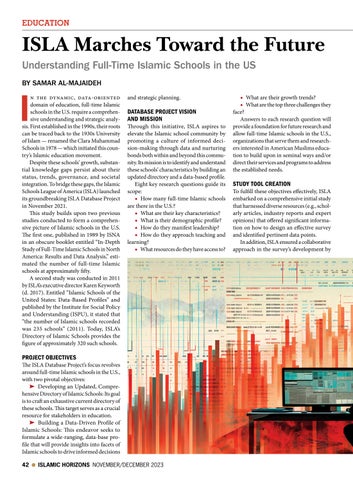EDUCATION
ISLA Marches Toward the Future Understanding Full-Time Islamic Schools in the US BY SAMAR AL-MAJAIDEH
I
n the dynamic, data-oriented domain of education, full-time Islamic schools in the U.S. require a comprehensive understanding and strategic analysis. First established in the 1990s, their roots can be traced back to the 1930s University of Islam — renamed the Clara Muhammad Schools in 1978 — which initiated this country’s Islamic education movement. Despite these schools’ growth, substantial knowledge gaps persist about their status, trends, governance, and societal integration. To bridge these gaps, the Islamic Schools League of America (ISLA) launched its groundbreaking ISLA Database Project in November 2021. This study builds upon two previous studies conducted to form a comprehensive picture of Islamic schools in the U.S. The first one, published in 1989 by ISNA in an obscure booklet entitled “In-Depth Study of Full-Time Islamic Schools in North America: Results and Data Analysis,” estimated the number of full-time Islamic schools at approximately fifty. A second study was conducted in 2011 by ISLA’s executive director Karen Keyworth (d. 2017). Entitled “Islamic Schools of the United States: Data-Based Profiles” and published by the Institute for Social Policy and Understanding (ISPU), it stated that “the number of Islamic schools recorded was 235 schools” (2011). Today, ISLA’s Directory of Islamic Schools provides the figure of approximately 320 such schools.
and strategic planning.
DATABASE PROJECT VISION AND MISSION
Through this initiative, ISLA aspires to elevate the Islamic school community by promoting a culture of informed decision-making through data and nurturing bonds both within and beyond this community. Its mission is to identify and understand these schools’ characteristics by building an updated directory and a data-based profile. Eight key research questions guide its scope: ◆ How many full-time Islamic schools are there in the U.S.? ◆ What are their key characteristics? ◆ What is their demographic profile? ◆ How do they manifest leadership? ◆ How do they approach teaching and learning? ◆ What resources do they have access to?
PROJECT OBJECTIVES
The ISLA Database Project’s focus revolves around full-time Islamic schools in the U.S., with two pivotal objectives: ➤ Developing an Updated, Compre hensive Directory of Islamic Schools: Its goal is to craft an exhaustive current directory of these schools. This target serves as a crucial resource for stakeholders in education. ➤ Building a Data-Driven Profile of Islamic Schools: This endeavor seeks to formulate a wide-ranging, data-base profile that will provide insights into facets of Islamic schools to drive informed decisions 42
ISLAMIC HORIZONS NOVEMBER/DECEMBER 2023
◆ What are their growth trends? ◆ What are the top three challenges they face? Answers to each research question will provide a foundation for future research and allow full-time Islamic schools in the U.S., organizations that serve them and researchers interested in American Muslims education to build upon in seminal ways and/or direct their services and programs to address the established needs.
STUDY TOOL CREATION
To fulfill these objectives effectively, ISLA embarked on a comprehensive initial study that harnessed diverse resources (e.g., scholarly articles, industry reports and expert opinions) that offered significant information on how to design an effective survey and identified pertinent data points. In addition, ISLA ensured a collaborative approach in the survey’s development by
